Module 4: Theory & Practice of Agricultural Extension
1/74
There's no tags or description
Looks like no tags are added yet.
Name | Mastery | Learn | Test | Matching | Spaced |
|---|
No study sessions yet.
75 Terms
The Universe of Extension
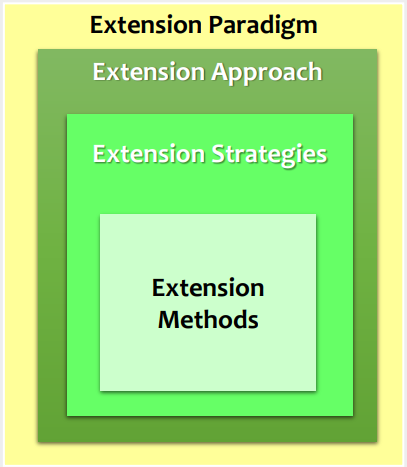
Extension Paradigm
How extension is viewed
Extension Approach
How extension is organized
Extension Strategy
How to operationalize the extension approach
Extension Method
What teaching or communication techniques to apply in each extension strategy
Technology Transfer
Non-formal Education
Human Resource Development
Facilitation for empowerment
Knowledge Management
Provision of Advisory Services
Extension Paradigms (6)
R → Research
D → Development
E → Extension
Continuum
What does RDE stands for in the RDE Continuum?
Research Phase
Technology Transfer:
- Knowledge/technology generation & development.
Extension Phase
Technology Transfer:
- Knowledge/technology transfer & utilization
SMS – Subject Matter Specialists
AEWs – Agricultural Extension Workers
LFTs – Lead Farmer Technicians
Small Farmers/Fishers – End-users
Key Intermediaries in the Technology Transfer chain (4)
Research → Translation → SMS → AEWs → LFTs → Small Farmers/Fishers
the Technology Transfer flow in order.
Formal
Non-formal (extension, village-level classes)
Informal (education at work setting, etc.)
(3) Types of Education
Formal
Primary, Secondary, University, polytechnic, ITEs
Non-formal
extension, village-level classes
Informal
education at work setting, etc.
It represents non-formal education activities that continue learning beyond formal schooling.
What does the “extension” in the education continuum represent?
Lifelong learning
timeline of birth to death represents?
Human Resource Development
Generally, building the social capital of clients.
Specifically, capability building of the agriculture, fisheries and natural resources and rural sectors.
Technical/technological
Business
Organizational
Facilitation for empowerment
Extension employs participatory approach.
Extension facilitates knowledge interaction where participants make their own decision
Knowledge Management
To make the best use of knowledge by generating, capturing, sharing, and applying it effectively.
Generate
Capture
Share
Apply
(4) Stages of Knowledge Management
Efficient use of
People
Processes
Technology
Networks
(4) Elements that need for effective Knowledge Management
Generate Stage
Knowledge Management:
- New knowledge is created through research and innovation.
Capture Stage
Knowledge Management:
- Knowledge is recorded, organized, and stored for future use (e.g., in databases or reports).
Share Stage
Knowledge Management:
- Knowledge is communicated or transferred to others through meetings, trainings, or publications.
Apply Stage
Knowledge Management:
- Knowledge is used in practice—to make decisions, improve methods, or create new technologies.
Provision of Advisory Services
Dissemination of information about technologies, markets, inputs and financial services.
Development of farming and management skills.
Brokering interactions between farmers, the private sector, research, education, and government.
Coaching different actors to improve market access, deal with changing patterns of risk, and protect the environment
Provision of Advisory Services
Strengthening capacities
Empowering rural people
Promoting innovations
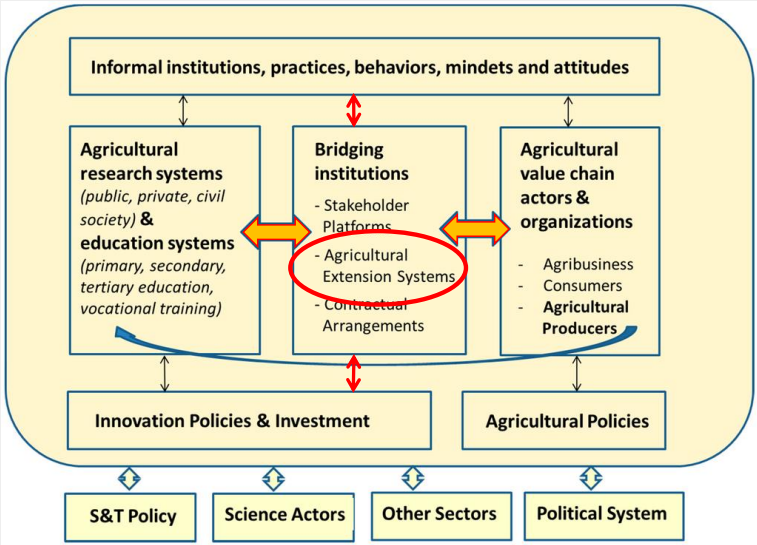
Agricultural Innovation System (AIS)
Role of advisory services in the AIS: Broker of knowledge
Extension Approach
encompasses the philosophy and style of action which informs, stimulates, and guides the extension system, its nature/ type of structure, leadership, programs, resources and linkages.
the dominant guide and style of an extension system or organization to achieve the system’s goals and objectives most effectively.
an organized or coherent combination of strategies and methods to make rural extension more effective (Haverkort and Roling, 1991).
General Extension Approach
Commodity Specialized Approach
Training And Visit Approach
Agricultural Extension Participatory Approach
Project Approach
Farming Systems Development Approach
Cost-sharing Approach
Educational Institution Approach
(8) Extension Approaches:
- Based on Axinn (1988)
Scheme Approach
Commodity Approach
Technical Change Approach
Target Category Approach
Functional Group Approach
Farmers’ Organization Approach
(6) Extension Approaches:
- Based on ICRE (1991)
Extension Approach:
GENERAL EXTENSION APPROACH
Basec on Axinn, 1988
assumes that technology and knowledge that are appropriate for local people exist but are not being used by them.
usually fairly centralized and government-controlled.
success measures: adoption rate of recommendations and increases in national production.
It can interpret national government policies and procedures to rural people.
Usually covers the whole nation. Relatively easy to control by central government.
There are officers and staff in every political division, ensuring continuity of extension programs.
When it works well, it provides for rapid communication from department level to rural people
(4) General Extension Approach ADVANTAGES
It lacks “two – way communication.”
Communication about farmers’ problem, needs and interest tends not to flow up through the extension channels.
Field staff tend to be not accountable to the rural people: may ignore priorities of local people while trying to satisfy supervisors.
It is expensive and inefficient since messages are inappropriate, the impact is low and cost of personnel is very high.
(4) General Extension Approach DISADVANTAGES
Extension Approach:
COMMODITY SPECIALIZED APPROACH
Basec on Axinn, 1988
key characteristic: groups all the functions for increased production - extension, research, input supply, marketing and prices - under one administration.
fairly centralized and is oriented towards one commodity.
managed and financed by commodity organization.
agent has many functions.
Messages are appropriate as technology is “fit” the production problems
Efficient, timely and effective delivery due to better coordination with research, input supply and marketing of output.
Focus on narrow range of technical concerns, closer management and supervision, fewer farmers per AEW.
Easier to monitor, evaluate and relatively more cost effective.
(4) Commodity Specialized Approach ADVANTAGES
Farmers’ interest may have less priority
Usually difficult to handle conflicts
Fails to provide advisory services to other aspects of farming when farmers produce more commodities
Farmers are confused with several extension workers from different agencies, with competing advice or demands.
With narrow focus, environmental factors may be ignored
(5) Commodity Specialized Approach DISADVANTAGES
Extension Approach:
TRAINING AND VISIT APPROACH
Basec on Axinn, 1988
fairly centralized based on a rigorously planned schedule of visits to farmers and training of agents and subject matter specialists.
close links maintained between research and extension.
agents are only involved in technology transfer.
success measures: increases in the production of particular crops or commodities.
Government is forced to organize a number of agricultural extension units into one integrated service
AEWs are forced to get out of their offices and meet with farmers.
With regular training, AEWs are more up to date with information and technology.
Field staff receives greater technical supervision
Logistical support to extension staff are more available
(5) Training and Visit Approach ADVANTAGES
Technology is not enough to increase production
Often bias in favor of the rich or more powerful in selecting contact farmers.
Top-down and supply driven.
Recommendations are not prompted by farmers’ expressed needs
High long term cost to the government.
Change from place to place and from time to time
(6) Training and Visit Approach DISADVANTAGES
Extension Approach:
AGRICULTURAL EXTENSION PARTICIPATORY APPROACH
Basec on Axinn, 1988
Focus: expressed needs of farmers' groups
Goals: increased production and an improved quality of rural life.
decentralized and flexible.
Success measures: numbers of farmers actively participating and sustainability of local extension organizations.
Failure of previous models
Simplistic measures of success and corresponding under-estimation for institution building
Lack of ownership by intended beneficiaries
Unresponsiveness to variation in farmer needs and priorities
Failure to reach poor and women farmers
Fiscal Reasons
High and unsustainable public cost
Shrinking public sector budget and resources to support extension
Governance related concerns
Emergence of active civil society
Decentralization of government authority and control
Search for more responsive models
(3) Why Participatory Extension
Mutually supportive relationship develops among participants
Increase confidence, awareness, and activity among farm people
Greater empowerment resulting from a bottom up decision making approach
(3) Agricultural Extension Participatory Approach ADVANTAGES
Difficult to manage
Central reporting and accounting
(2) Agricultural Extension Participatory Approach DISADVANTAGES
Extension Approach:
PROJECT APPROACH
Basec on Axinn, 1988
concentrates efforts on a particular location, for a specific time period, often with outside resources.
purpose: often to demonstrate techniques and methods that could be extended and sustained after the project
success measure: change in the short term
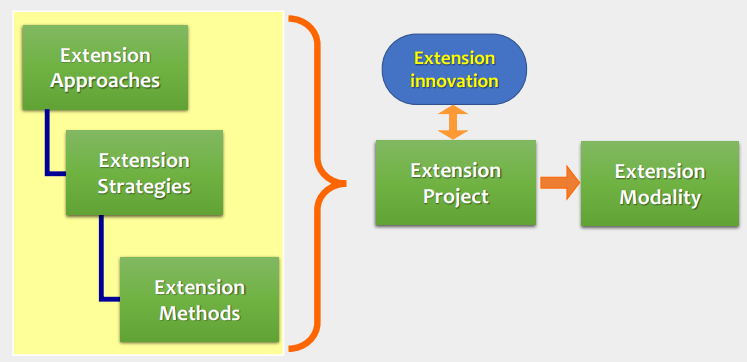
Exntension Intervention
It can give quick results
Novel techniques and methods can be tested and experimented
(2) Project Approach ADVANTAGES
Time is too short, ends when budget ends
Tend to consume large resources on baseline surveys and the establishment of temporary logistic base.
Staff both local and expats tend to become the immediate beneficiaries
Pressure to show immediate results leading to fictitious reporting
Innovations introduced are quickly abandoned once external funding ceases
(5) Project Approach DISADVANTAGES
Extension Approach:
FARMING SYSTEMS DEVELOPMENT APPROACH
Basec on Axinn, 1988
key characteristic: systems or holistic approach at the local level
close ties with research are required and technology for local needs is developed locally through an iterative process involving local people
success measures: extent of local people adoption and continue to use technologies developed
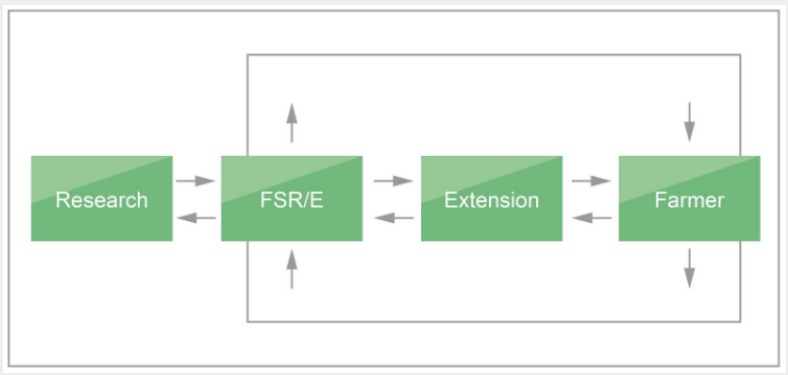
FSR/E Model
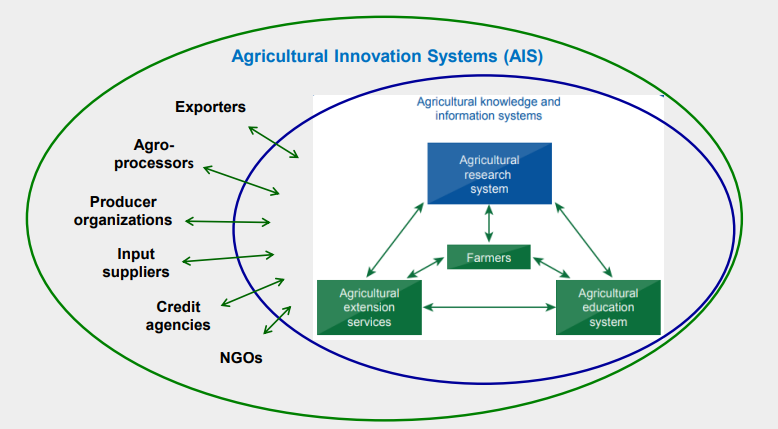
AKIS & AIS models
Farmers can easily see the results in the application of technology in the field
Strong linkages between extension and research personnel
Farmers are committed to use the technologies they helped to develop
(3) Farming Systems Development Approach ADVANTAGES
Only one farmer cooperator benefits
The farmer cooperator cannot continue the operation after the end of the project.
Little adoption of the technology packages due to failure in addressing farmers’ socio-economic and institutional environments
Costs can be high, and results can be slow
(4) Farming Systems Development Approach DISADVANTAGES
Extension Approach:
COST-SHARING APPROACH
Basec on Axinn, 1988
assumes that cost-sharing with local people will promote a programme that is more likely to meet local situations and where extension agents are more accountable to local interests.
Purpose: to provide advice and information to facilitate farmers' self-improvement.
Success measure: willingness to pay
Local program planning increases the relevance of the program content and methods to the needs and interests of clientele
Higher adoption rates
Local influence on personnel selection, contributes to their ability to communicate effectively and win the confidence of rural people
Lower cost of central government
(4) Cost-sharing Approach ADVANTAGES
More difficult for central government to control either program or personnel
Reporting financial management, and other aspects of administrative concerns tend to be more complex and difficult
(2) Cost-sharing Approach DISADVANTAGES
Extension Approach:
EDUCATIONAL INSTITUTION APPROACH
Basec on Axinn, 1988
uses educational institutions which have technical knowledge and some research ability to provide extension services for rural people
implementation and planning: often controlled by those who determine school curricula.
Emphasis: transfer of technical knowledge.
It can help the schools in providing real world relevant examples to their academic teaching materials (build practical into classroom)
Good training for scientists and field extension personnel
More efficient use of human resource due to borrowing personnel from educational institution , instead of maintaining AEWs as part of their own professional staff
(3) Educational Institution Approach ADVANTAGES
Instructors as trainers of field extension staff tend to speak too academically
Lectures and demonstration may not be as practical and useful from a farmer’s perspective
Competition between the LGU extension workers and extension staff of the university
(3) Educational Institution Approach DISADVANTAGES
GENERAL EXTENSION APPROACH
Extension Programs of the Agricultural Training Institute
COMMODITY SOECIALIZED APPROACH
Rice Extension Program of RCEP
TRAINING AND VISIT APPROACH
National Extension Program during the Green Revolution
AGRICULTURAL EXTENSION PARTICIPATORY APPROACH
Farmers Field School
PROJECT APPROACH
Development of Farm Business School
FARMING SYSTEMS DEVELOPMENT APPROACH
Techno Gabay Program of ATI and DOST
COST-SHARING APPROACH
Collaborative Extension Programs among Extension agencies
EDUCATIONAL INSTITUTION APPROACH
Farmer Scientists Training Program of UPLB
Extension Approach:
SCHEME APPROACH
Based on ICRE, 1991
Organized and coherent combination of extension strategies and methods which aims at the reinforcement of the rules and regulations of a scheme
Communication is used to instruct and/or convince the tenants of the scheme to abide to the rules
Example: Extension to support the enforcement of an Irrigation Scheme.
Extension Approach:
COMMODITY APPROACH
Based on ICRE, 1991
Extension approach that facilitates the production of one specific crop (commodity).
The extension content is limited to technical and administrative or commercial aspects of the production of the commodity ❑ Extension is managed by the society or board which frequently has monopolized the markets
Example: Extension support for banana for export.
Extension Approach:
TECHNICAL CHANGE APPROACH
Based on ICRE, 1991
The most common extension approach that aims at the maximum adoption of a number of innovations
Technical information is diffused indiscriminately within the rural society – first to a small number of ‘progressive farmers‘ in the hope that autonomous diffusion processes will multiply the impact of the intervention
Example: Extension intervention for massive adoption of biotechnology, organic agriculture, etc.
Extension Approach:
TARGET CATEGORY APPROACH
Based on ICRE, 1991
Extension approach which provides carefully selected information, and other support for the specific needs of deliberately chosen categories in the population based on the similarities of their needs and/or opportunities
Example: Extension Programs for RICs, IPs, etc.
Extension Approach:
FUNCTIONAL GROUP APPROACH
Based on ICRE, 1991
Extension approach where one of the prime targets is to form groups who join the efforts to mobilize the necessary resources to be able to achieve a shared goal
The change in behavior of the participants is carried out through mobilization, organization, training, technical and resource support, and special efforts to consolidate and replicate the results
Example: Extension programs for rural reconstruction
Extension Approach:
FARMERS’ ORGANIZATION APPROACH
Based on ICRE, 1991
Extension approach where independent, self-management, and in most cases permanent organizations are formed with the objective to propagate some kind of social or economic development for the members
The organization seeks their objective by setting up social and/or economic activities, for which they sometimes hire professionals or technician.
Example: Extension programs for farmers’ organizations
Client-oriented approaches
Farm-family approach
Demand-driven approach
Private extension approach
Farmer-led extension approach
Agri-tourism approach
Alternative Approaches (6)